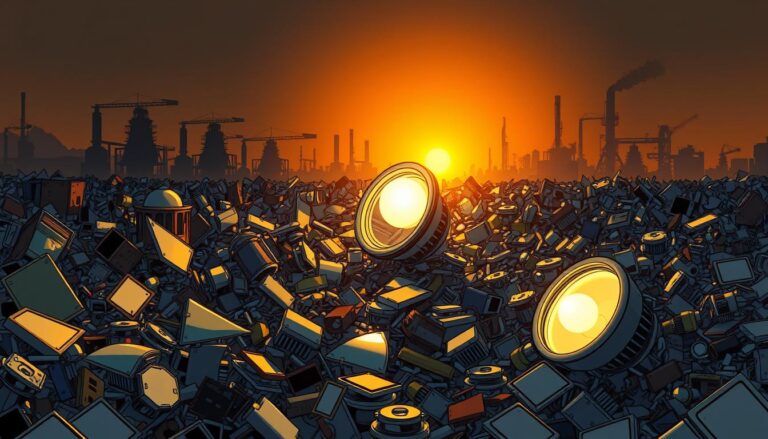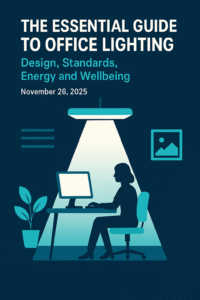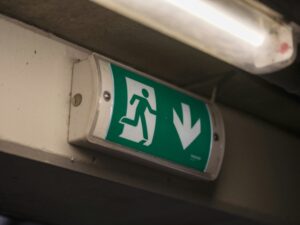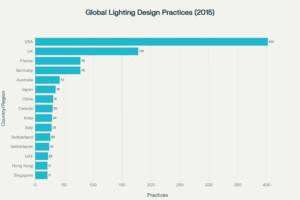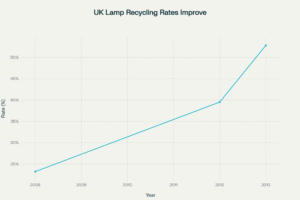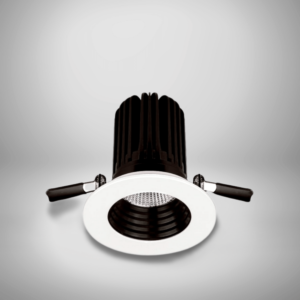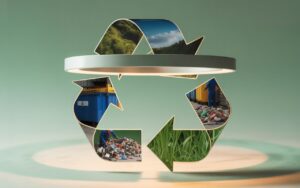One in four commercial lights is replaced too soon because they can’t be repaired. This leads to so much lighting waste that many estates managers don’t see.
We show how to stop lighting waste by using regenerative manufacturing methods, fixing lights again, and making closed-loop systems. Our goal is simple: every light should be fully fixed and reusable, reducing waste and saving money for our clients.
The new British Standard BS 8887-221:2024 is important for a circular lighting economy in the UK. It focuses on making lights last longer, being easy to take apart, and caring for the environment. It gives a clear guide for makers and those choosing lights.
Lumenloop shows what’s achievable: lights that can be changed easily, and systems to get materials back. These steps make fixing lights again possible on a big scale. They also make following circular lighting rules easier.
There’s more to it than just saving the planet. Circular lighting also helps businesses by cutting material costs, energy use, and waste disposal costs. Real-life examples show how sustainable lighting can bring in money from the start.
In the next parts, we’ll look at the problem of lighting waste, its environmental effects, and how to solve it. We’ll share strategies for design, fixing lights, closed-loop systems, getting people involved, policy changes, and new technologies. This way, teams, lighting experts, and makers can start making a difference now.
Introduction to Lighting E-Waste
We start by explaining what lighting e-waste is and why it’s important. This section is for facility managers, lighting consultants, and engineers. It gives them the definitions and actions they need quickly.

What is Lighting E-Waste?
Lighting e-waste includes old lights, lamps, drivers, and electronics from various places. This includes LED lights, fluorescent tubes, HID lamps, and control gear. We also count bulbs, ballasts, remote drivers, and sensors as part of this group because they need the same handling.
Many buildings switch to LEDs, but the old fixtures still need to be disposed of safely. Knowing what is considered lighting e-waste helps teams track and reclaim it properly.
Why Lighting E-Waste Matters
Old fluorescent and HID lamps can harm soil and water if not disposed of correctly. LEDs don’t have mercury but still have valuable metals and semiconductors. These need to be processed properly to avoid wasting resources.
The World Resources Institute says a big part of global greenhouse gases come from making and using products. The carbon in lighting production is wasted if not reclaimed. This makes making things last longer and designing lights sustainably very important.
In the UK, there are rules about dealing with WEEE lighting. Big companies and shops now offer ways to return old lights. Using these services helps reduce waste and saves materials.
Choosing sustainable lighting design and remanufacturing helps the environment. We suggest checking if lights can be remounted, have parts taken out, or refurbished before throwing them away. This saves time, money, and helps keep materials in use.
The Impact of Lighting E-Waste on the Environment
We explore how discarded lights affect soil, water, and carbon. Lighting waste is more than just trash in bins. It involves losing valuable resources, risking contamination, and missing chances to save energy.
Older light types are dangerous when thrown away. They can leak harmful materials like mercury into the ground. This is a big problem, causing local pollution and making recycling hard.
LEDs are different. They don’t have harmful materials like mercury. They are safer and can be recycled, saving valuable resources.
Energy use over a light’s life is important. Different lights use different amounts of energy. LEDs use much less than old lights like incandescent bulbs.
LEDs are also more efficient. They can be up to four times better than old fluorescent lights. This means they use less energy and make less carbon dioxide.
LEDs last longer, too. They can last 3 to 5 times longer than old lights. This means we need to replace them less often, reducing waste.
Recycling LEDs is key to saving resources. We can get materials like aluminium and copper back. This helps make new lights and saves energy.
We need to change how we handle lights. Instead of just throwing them away, we can recycle and reuse. This helps the environment and saves resources.
We can tackle two big problems at once. We can make disposing of lights safer and use less energy. By choosing the right materials and supporting recycling, we can make lighting better for the planet.
| Issue | Traditional Lamps | LEDs / Circular Approach |
|---|---|---|
| Hazardous materials | Mercury in fluorescents; metals in HID | No mercury; fewer hazardous components; easier recycling |
| Energy consumption lighting | High power use; lower efficacy | Higher luminaire efficacy; significant energy and carbon savings |
| Lifespan and waste | Shorter life; frequent replacements | 3–5× longer life; reduced replacement waste |
| Materials recovery | Limited recovery; contamination risk | Aluminium, copper, glass, semiconductors reclaimable for remanufacture |
| Role of remanufacturing | Rare; mostly disposal | Enables closed-loop value retention and lower lifecycle impacts |
Innovative Sustainable Design Strategies
We share practical design steps to reduce waste and extend product life. Making smart choices now can save on disposal costs later. It also makes maintenance easier for facilities teams.
Eco-Friendly Materials
Choose materials that are easy to recycle. Aluminium housings and thermoplastics that separate well from metal help recycling. This supports sustainable lighting design goals.
LEDs made with inert semiconductors are safer. Suppliers like Signify publish material declarations. This supports responsible sourcing and traceability.
Ask for minimal potting and limited permanent adhesives. This boosts the chance of component reuse. It follows eco-friendly materials lighting principles.
Designing for Disassembly
BS 8887-221:2024 outlines how to design for disassembly. We use tool-free fastenings and modular LED arrays. This makes repairs easy.
Modularity allows replacing or upgrading only what’s needed. Repro-Light and Signify show how no-glue assemblies help at the end of life. They support the circular lighting economy.
Networked luminaires with upgradable firmware reduce the need for whole-unit replacement. Remote updates and swappable sensors keep fittings useful longer.
Here’s what specifiers and facility managers can do:
- Specify replaceable drivers and visible part numbers.
- Demand clear disassembly guides and accessible fastenings.
- Choose manufacturers offering take-back or refurbishment schemes to support the circular lighting economy.
The Role of Remanufacturing in Reducing Waste
Remanufacturing is a process where old lights are fixed and made new again. This way, we can use things longer and save resources. It helps reduce waste and supports a sustainable lighting system.
Remanufacturing has many benefits. It keeps lights out of landfills and cuts down on carbon emissions. It also saves money for facilities by making lights last longer and needing less repairs.
Facility managers can start this process quickly. They just need to follow a few steps.
- Check what lights you have to see which ones are worth fixing.
- Choose lights that are easy to take apart and fix.
- Work with companies that can fix and sell used lights.
- Plan how to fix lights without stopping work.
- Keep track of how much waste you save and money you make.
There are real examples of how remanufacturing works. Philips fixes old lights and sells them again, saving money and resources. Signify makes lights that are easy to take apart for recycling. Lumenloop shows how lights can be fixed without tools, making recycling easier.
Remanufacturing also saves money. It cuts down on the cost of materials and energy. When you add in longer life and less repairs, it’s even more cost-effective. Companies can even pay for this service, making it predictable and affordable.
Here’s how to start:
- Find out which lights you can fix and when.
- Ask for lights that are easy to fix when you buy new ones.
- Make sure the company you work with meets your goals for waste and energy.
- Try it out in a small area first to see how it works.
By following these steps, we can make our lighting systems more sustainable. Remanufacturing helps us use resources better and reduces waste. It’s good for the planet and saves money too.
Understanding Closed-Loop Luminaires
We explain how closed-loop luminaires turn waste into value. These systems use modular parts and take-back services. They aim to reduce lighting e-waste and support a circular economy.
What are closed-loop luminaires?
Closed-loop luminaires are made for reuse. They have designs that make disassembly easy. Companies like Lumenloop and Philips have programmes to take back old units, refurbish them, and recycle materials.
These systems include modular parts and take-back services. They also have centres for refurbishment and recycling. Tracking data helps us understand how well they work.
Benefits of closed-loop systems
Using closed-loop systems greatly reduces lighting e-waste. It keeps materials in use, lowering carbon emissions. This approach also makes it easier to follow environmental laws.
Businesses benefit too. Remanufacturing products saves money on buying new ones. It also cuts down on disposal costs. Plus, it makes upgrading easier with modular parts and updates.
Practical steps we recommend:
- Choose suppliers with clear take-back and remanufacturing services.
- Include end‑of‑life clauses in procurement contracts.
- Set KPIs for waste diverted, energy saved and cost efficiency.
Real examples show it works. Signify and Philips have big recycling efforts. Lumenloop’s approach shows how it can work in commercial settings, saving money and supporting a circular economy.
Consumer Awareness and Education
We need to make recycling lighting easy for everyone. Clear instructions help avoid mistakes and keep harmful materials out of landfills. This way, we can reuse parts and reduce the need for new materials.
Importance of Recycling Lighting Products
Proper recycling stops old lamps from leaking into the environment. It also lets us recover valuable parts. A simple recycling process supports sustainable lighting in all projects.
Big brands and many shops take old bulbs for recycling. The UK has places where you can drop off old electronics. Companies can also take back old bulbs, making it easier for facilities to meet green goals.
How Consumers Can Participate
There are simple steps to follow. Keep records of your light fixtures and serial numbers. This way, you can replace them with the right ones.
Separate LED parts, drivers, and batteries before throwing them away. Arrange for bulk recycling with suppliers or approved recyclers. This makes handling easier.
For workplaces, set up recycling points. Train cleaning staff and include recycling in reports. When buying new lights, choose vendors that offer recycling or take-back.
Ask for guides on how to disassemble lights. Include recycling in contracts with suppliers. This promotes a circular economy in lighting.
Education is key. Organise briefings and workshops for occupants and suppliers. This reduces mistakes and boosts recycling efforts. It helps make recycling a part of daily life.
Policy and Regulation Addressing E-Waste
We look at how rules affect what manufacturers do and where policy is going. Clear rules help businesses and encourage circular practices. Teams can follow these steps to meet standards and make products attractive for public contracts.
Current legal framework
In the UK and EU, 11 make producers pay for collecting and treating old lighting. RoHS limits harmful substances like mercury, pushing for LEDs and easier recycling. BS 8887‑221:2024 guides on designing for disassembly, helping apply circular principles.
What this means for manufacturers
Companies that focus on sustainable lighting and repair can save money and avoid legal trouble. They can include take-back clauses in contracts and document materials for reporting. This makes their bids stronger when circular economy criteria are in tenders.
Emerging policy directions
We expect stricter e-waste rules and more extended producer responsibility (EPR). Future rules will ask for more material transparency and labels for repairability. Policy is moving towards incentives for remanufacturing and circular economy goals in tenders.
Preparing your business
Make sure products meet BS 8887‑221:2024 and include remanufacturability in designs. Track waste diverted and materials reclaimed. Keep up with WEEE UK updates and consider take-back costs in product life cycles.
Global alignment and collaboration
Industry groups and UN initiatives like STEP work on common standards and shared take-back schemes. UK companies can use these to simplify international compliance and support circular economy solutions.
| Policy Area | Current Status | Practical Action |
|---|---|---|
| WEEE producer obligations | Producers must finance collection and treatment under WEEE UK rules | Set up compliant take‑back, record flows and report annually |
| Restriction of hazardous substances | RoHS restricts mercury and similar substances, aiding LED uptake | Specify non‑hazardous components and favour LEDs for recyclability |
| Design standards | BS 8887‑221:2024 advises design for disassembly | Adopt modular assemblies and clear repair manuals |
| Extended Producer Responsibility (EPR) | Expansion signalled across policy discussions | Model EPR costs into product pricing and contractual terms |
| Transparency and labelling | Move towards stronger material and reparability disclosure | Introduce matrix labels for parts, materials and remanufacture routes |
| Public procurement | Circular criteria increasingly used in tenders | Document life‑cycle benefits and include take‑back capability in bids |
Collaborations Between Manufacturers and Communities
We need to work together to cut down on lighting e-waste. This means joining forces between manufacturers, facilities teams, local authorities, and recyclers. Together, we can keep products in use for longer and support local needs.
Partnerships for Sustainable Practices
It’s wise to have formal take-back agreements. This sets out who does what. Companies like Philips and GE can send over fixtures ready for refurbishment. Councils can offer places to drop off items and set up regular collection times.
Facilities managers can sort and store items for transport to remanufacturing centres. Here’s how to start:
- Make deals with certified remanufacturers.
- Work out logistics with local hauliers for regular pickups.
- Set up ways for teams to know how and when to return items.
Community Programs for Lighting E-Waste
Local events and drop-off points make recycling easy and visible. Supermarkets and hardware stores can take back bulbs and lights. Municipal WEEE collections accept mixed lighting e-waste and send it to remanufacturers.
This approach helps communities get affordable lighting for schools, social housing, and community centres. It also lets manufacturers reuse valuable parts while keeping costs down for everyone.
| Stakeholder | Role | Key KPI |
|---|---|---|
| Manufacturer | Provide take-back, refurbishment and technical support | Units returned per quarter |
| Local Authority | Host collection points and run community take-back events | Tonnes of lighting e-waste diverted annually |
| Facilities Team | Manage onsite collection, staging and handover | Collection compliance rate and cost savings |
| Remanufacturer | Refurbish, test and reissue products into the market | Materials recovered and CO2 avoided |
| Retailer | Offer convenient drop-off and awareness campaigns | Public participation rate |
We track our success with simple KPIs. These include the number of units returned, materials recovered, cost savings, and CO2 avoided. These metrics show the benefits of a circular lighting economy.
When we align our efforts in procurement, logistics, and reporting, we see better results. More remanufactured lighting products are used, and recycling in communities improves. This approach keeps value in the system and reduces waste for councils and businesses.
Advances in Technology for E-Waste Reduction
Technology is changing fast, helping reduce waste in lighting systems. New methods combine design, software, and recyclable materials. This makes sustainable lighting a reality.
Smart Lighting Solutions
Choose lighting fixtures that can update software remotely and have modular boards. Networked lights can get new features without needing a full replacement.
Sensors and controls adjust light to save energy and last longer. If something breaks, just replace the part, not the whole light.
Services like lighting as a service and remote checks help avoid unnecessary changes. This keeps lights working longer and makes repairs easier, reducing waste.
Innovations in Material Science
New materials make recycling easier. Now, we can get copper from PCBs, melt aluminium, and reuse semiconductor substrates.
Designs without glue or potting make recycling simple. LEDs last up to 100,000 hours, reducing the need for frequent replacements.
Modular lights let us upgrade parts, not the whole thing. This way, we can change a light to meet new needs, helping reduce waste.
To make a difference, choose vendors that recycle and design for upgradeability. This turns innovation into real waste reduction.
Moving Towards a Sustainable Lighting Future
We’ve learned that cutting down on lighting e-waste needs teamwork. Designers, remanufacturers, and closed-loop systems must work together. By using modular, repairable lights, we can reduce waste and make fixes easier.
When managers and lighting experts choose easy-to-take-apart products, it’s good for everyone. It makes fixing lights cheaper and more efficient over time.
There are steps we can take today. We should work with suppliers who take back old products and measure how much waste we avoid. By doing this, we can save energy and money.
Using LED and NIR technologies can also help. They make lights last longer, safer, and cut down on waste. This way, we can reduce the amount of e-waste in landfills.
Building strong partnerships with makers and remakers is key. This approach leads to cost savings, durable assets, and less harm to the environment. By recycling, we can make lighting systems that are good for everyone and the planet.
FAQ
What counts as lighting e-waste?
Lighting e-waste includes old lamps, drivers, and electronics from homes and businesses. This includes LED lights, fluorescent tubes, and HID lamps. It also covers control gear and parts like ballasts and sensors.
Why does lighting e-waste matter?
Lighting e-waste is a big problem because it fills landfills and can leak harmful substances. It also wastes valuable materials and energy. The World Resources Institute says 45% of global emissions come from making and using products.
Are LEDs hazardous to recycle?
Modern LEDs are safer than older lamps because they don’t have mercury. But, they still have metals and plastics that need to be recycled properly. This ensures we get the most value from them.
What hazardous materials are found in older lighting?
Older lamps, like fluorescent and HID, often have mercury and other harmful substances. If thrown away, they can pollute soil and water. They also have lead and special glass that need careful handling.
How much energy can LED luminaires save compared with older systems?
LED lights are much more efficient than older ones. They use a lot less energy and produce fewer emissions. Adding smart controls can save even more energy.
What is remanufacturing of lighting products?
Remanufacturing means fixing and updating used lights to make them almost new again. It saves materials and energy. It also helps reduce waste and pollution.
What are closed‑loop luminaires?
Closed-loop luminaires are made to be recycled or refurbished. They are designed to be easily taken apart and rebuilt. This way, materials are constantly being reused.
What business benefits does circular lighting offer?
Circular lighting can save businesses money and reduce waste. It also helps them make more money by selling refurbished products. It makes planning and buying easier too.
How does BS 8887‑221:2024 affect lighting design?
BS 8887‑221:2024 encourages designing lights that can be easily taken apart and recycled. It promotes making lights that last longer and can be fixed. This helps the environment.
What practical design strategies reduce lighting e‑waste?
To reduce waste, use materials that can be recycled. Make lights easy to take apart. Use modular parts and design for easy upgrades. This helps extend the life of lights.
Which manufacturers run remanufacturing or take‑back programmes?
Companies like Signify/Philips and Lumenloop have programmes to recycle lights. They refurbish lights and make new ones from recycled materials. This helps the environment and saves resources.
How should facility managers prepare for remanufacturing or closed‑loop procurement?
Facility managers should check what lights they have and see if they can be updated. They should work with companies that recycle lights. This helps save energy and money.
What operational steps are needed for reverse logistics?
To handle reverse logistics, set up places to collect old lights. Work with suppliers or recyclers to pick up lights. Make sure lights are properly stored and handled.
How does recycling recover value from luminaires?
Recycling lights gets valuable materials back. It recovers metals, glass, and semiconductors. These materials can be used again, saving energy and resources.
What role do smart lighting and firmware updates play?
Smart lights and updates can make old lights work better. They add new features without needing new hardware. This saves money and reduces waste.
How can procurement enforce circularity with suppliers?
To promote recycling, ask suppliers for lights that can be fixed or recycled. Include recycling plans in contracts. Ask for information on how materials are used and recycled.
What regulations should UK businesses be aware of?
UK businesses must follow rules on waste and hazardous materials. The BS 8887‑221:2024 guide helps with design. Future rules will likely make recycling even more important.
How can community programmes support lighting circularity?
Community programmes can collect and recycle lights. They can also give remanufactured lights to schools and community centres. This helps extend the life of lights and saves resources.
What KPIs should organisations track for circular lighting?
Track how many lights are recycled, materials recovered, and waste reduced. Also, measure energy saved, cost savings, and the percentage of lights remanufactured.
Are there service models that simplify circular lighting adoption?
Yes, there are services that handle maintenance and recycling for you. This makes it easier to adopt circular lighting. It also helps keep costs stable.
How quickly can organisations see ROI from circular lighting?
ROI depends on how much energy is saved and the cost of refurbishing lights. Many companies see savings quickly. Remanufacturing also helps reduce carbon emissions.
What immediate steps can a lighting consultant or MEP team take?
Choose lights that can be easily fixed or recycled. Work with suppliers who offer recycling. Plan updates carefully and track progress to improve lighting systems.
